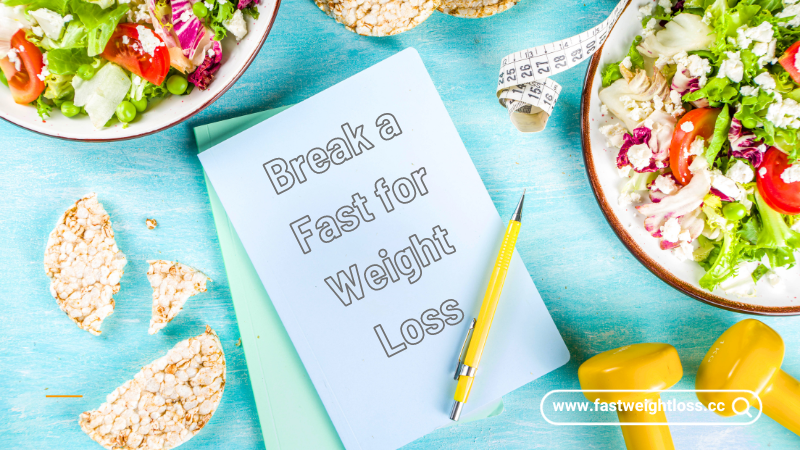The best way to break a fast for weight loss is to start with small, nutritious meals to ease your digestive system back into eating. Introducing food after a fast in a weight loss journey requires a balanced approach.
While it may be tempting to dive into indulgent foods, opting for small, nutritious meals can provide a smooth transition for your digestive system. We will explore the best ways to break a fast for weight loss, ensuring that you replenish your body’s energy without compromising your progress.
By following these tips, you can ensure a healthy and effective post-fast experience that supports your weight loss goals. So, let’s dive in and discover the optimal approach for breaking a fast in a weight loss regimen.
The Importance Of Breaking A Fast Correctly
Understanding the Role of Nutrient Intake after Fasting
The way you break a fast can have a significant impact on your weight loss goals. When you fast, your body enters a state of ketosis, where it uses stored fat as a source of energy. Breaking the fast correctly is crucial to maintain this fat-burning state and ensure optimal weight loss results.
Fasting depletes your body of essential nutrients, which need to be replenished when you start eating again. Your first meal after a fast should include a good balance of macronutrients – protein, carbohydrates, and healthy fats. This combination will provide your body with the necessary energy and help rebuild and repair tissues.
How Breaking a Fast Affects Weight Loss Results
Breaking a fast properly is not only about nourishing your body; it also plays a vital role in your weight loss journey. When you fast, your insulin levels drop, and your body becomes more sensitive to insulin. It means that when you break your fast with a meal, your body will utilize the nutrients more efficiently, preventing insulin spikes that can hinder your progress.
Additionally, breaking a fast correctly helps maintain your fat-burning potential. By consuming protein-rich foods during your first meal, you provide your body with the amino acids it needs for muscle repair and growth. This helps preserve your lean muscle mass and increase your metabolic rate, ultimately supporting your weight loss efforts.
Fasting has been shown to have a positive impact on metabolism – the process by which your body converts food into energy. When you fast, your body shifts from using glucose as its primary source of energy to utilizing stored fat, leading to fat loss. The longer the fasting period, the more your body relies on fat stores for fuel.
Breaking a fast correctly plays a crucial role in maintaining this heightened metabolic state. By providing your body with essential nutrients through a well-balanced meal, you support the metabolic processes and ensure a smooth transition from fasting to eating. This not only aids in weight loss but also helps regulate your metabolism in the long run.
Remember, breaking a fast correctly is essential for maximizing your weight loss results and maintaining a healthy metabolism. Be sure to consult a healthcare professional or a registered dietitian for personalized advice based on your specific needs.
Nutrient-dense Foods For Breaking A Fast
Breaking a fast in a healthy and nourishing way is crucial to maximize the benefits of intermittent fasting for weight loss. After a period of fasting, your body is primed to absorb nutrients efficiently. Therefore, it’s important to choose foods that are rich in essential nutrients to support your energy levels, metabolism, and overall well-being.
Incorporating Protein-rich Foods Into Your First Meal
When you break your fast, one of the key nutrients to prioritize is protein. Including protein-rich foods in your first meal after fasting can help stabilize blood sugar levels, promote muscle repair and growth, and keep you feeling satisfied for longer.
Consider incorporating the following protein-rich options into your first post-fast meal:
- Lean meats and poultry, such as grilled chicken or turkey breast
- Fatty fish like salmon, which is high in omega-3 fatty acids
- Dairy products like cottage cheese or Greek yogurt, which are also rich in calcium
- Eggs, a versatile and protein-packed option
- Plant-based proteins such as tofu, tempeh, or legumes like lentils or chickpeas
The Benefits Of Consuming Healthy Fats Post-fast
While fats are often demonized, incorporating healthy fats into your first meal after fasting can provide numerous benefits for weight loss and overall health. Including healthy fats can help increase satiety, support nutrient absorption, and promote a healthy hormonal balance.
Here are some examples of healthy fats you can consider integrating into your post-fast meal:
- Avocado, rich in heart-healthy monounsaturated fats
- Olive oil, a great source of anti-inflammatory fats
- Nuts and seeds like almonds, walnuts, chia seeds, or flaxseeds
- Fatty fish such as mackerel or sardines, which are high in omega-3 fatty acids
- Full-fat dairy products like grass-fed butter or cheese in moderation
The Role Of Carbohydrates In Replenishing Energy Stores
Carbohydrates play a critical role in replenishing your energy stores after a fast. They are the body’s preferred source of fuel and can help restore glycogen levels in the muscles and liver.
When choosing carbohydrates post-fast, opt for complex carbohydrates that are high in fiber, vitamins, and minerals, instead of refined or processed options. Here are some nutrient-dense carbohydrate sources:
| Vegetables | Whole Grains | Legumes |
|---|---|---|
| Leafy greens like spinach and kale | Quinoa, brown rice, or whole wheat bread | Black beans, lentils, or chickpeas |
| Broccoli, cauliflower, or Brussels sprouts | Barley, bulgur, or oats | Red kidney beans, pinto beans, or split peas |
| Bell peppers, carrots, or sweet potatoes | Millet, whole wheat pasta, or buckwheat | Edamame, black-eyed peas, or white beans |
Remember that the key to breaking a fast for weight loss is to prioritize nutrient-dense foods. By incorporating protein-rich foods, healthy fats, and quality carbohydrates into your first meal after fasting, you can nourish your body, support your weight loss goals, and maintain sustainable energy levels throughout the day.
Meal Timing And Frequency
When it comes to breaking a fast for weight loss, meal timing and frequency play a crucial role in maximizing your results. By strategically planning your meals and finding the perfect balance, you can ensure that you are making the most of your eating window while still promoting sustainable weight loss.
Optimal Timing For Breaking A Fast For Weight Loss
Choosing the right time to break your fast can greatly impact your weight loss goals. It is important to listen to your body and recognize its hunger cues. However, an optimal time frame for breaking a fast is typically within the first few hours of your eating window.
This timing allows your body to transition from a fasting state to a fed state gradually. Breaking your fast earlier in the day may also help kickstart your metabolism and provide you with sustained energy throughout the day. Aim to consume your first meal within 2-3 hours of waking up.
Strategies For Planning Meals During The Eating Window
Planning your meals during the eating window can help you make intentional choices that support your weight loss journey. Here are a few strategies to consider:
- Focus on nutrient-dense foods: Ensure that your meals are packed with essential nutrients, such as lean proteins, whole grains, fruits, vegetables, and healthy fats. These foods not only provide you with the necessary fuel but also promote feelings of satiety.
- Control portion sizes: Keep an eye on your portion sizes to avoid overeating. Use smaller plates or bowls to create the illusion of a fuller plate. Additionally, try to eat mindfully by savoring each bite and paying attention to your body’s cues of fullness.
- Incorporate balanced meals: Aim for a well-balanced plate that includes a mix of protein, carbohydrates, and fats. This combination helps stabilize blood sugar levels and keeps you feeling satisfied for longer.
Balancing Meal Frequency For Sustainable Weight Loss
Finding the right balance of meal frequency is essential for sustainable weight loss. While some people may thrive on three square meals a day, others may prefer smaller, more frequent meals. Here’s what you need to keep in mind:
- Listen to your body: Pay attention to your hunger and fullness cues. If you find that you feel satisfied with three meals a day, that’s completely fine. However, if you notice that you feel better with smaller, more frequent meals, consider incorporating 4-5 meals throughout your eating window.
- Avoid excessive snacking: While small snacks can be a part of a well-balanced eating plan, be cautious of mindless snacking. Snacking too often can lead to consuming excess calories and hinder your weight loss efforts. Opt for nutrient-dense snacks that keep you satisfied until your next meal.
- Experiment and adjust: Everyone’s metabolism and preferences are unique. It may take some trial and error to find the optimal meal frequency that works for you. Be flexible and open to adjusting your eating schedule as needed.
By focusing on optimal timing, planning your meals, and balancing frequency, you can break your fast for weight loss in a way that supports your goals while also promoting sustainable habits. Remember, consistency and finding what works best for your body are key components of achieving long-term success.
Hydration And Supplements After Fasting
Hydration and supplements after fasting play a crucial role in maximizing weight loss results. Replenishing your body with fluids and essential nutrients is necessary to support your overall health and ensure that your weight loss journey stays on track. In this article, we will explore the importance of rehydrating after a fast and the essential supplements you should consider taking to maximize your weight loss efforts.
The Importance Of Rehydrating After A Fast
When you break a fast, it’s essential to prioritize hydration. During a fasting period, your body may become dehydrated, and replenishing fluids is key to restoring balance and supporting your organs’ proper functioning.
- Restoring electrolyte balance: Fasting can cause imbalances in electrolytes like sodium, potassium, and magnesium. Rehydrating with fluids that contain electrolytes, such as coconut water or sports drinks, can help restore these balances.
- Aiding digestion: Proper hydration supports the digestive system and helps your body break down food more efficiently.
- Boosting metabolism: Drinking enough water can temporarily increase your metabolism, making it easier for your body to burn calories and aiding in weight loss.
Essential Supplements For Maximizing Weight Loss Results
In addition to rehydrating, incorporating certain supplements into your post-fast routine can help boost weight loss results. These supplements provide your body with the necessary nutrients to support fat burning, muscle recovery, and overall health. Here are some key supplements to consider:
- Protein powder: Adding a high-quality protein powder to your post-fast routine can help promote muscle recovery, maintain muscle mass, and support satiety, making it easier to manage your calorie intake.
- Omega-3 fatty acids: Omega-3 fatty acids have been shown to have numerous health benefits, including reducing inflammation and supporting heart health. Incorporating a fish oil or flaxseed oil supplement can help optimize your weight loss journey.
- Multivitamins: While fasting, you may miss out on essential vitamins and minerals. Taking a high-quality multivitamin can help fill these gaps and ensure that your body has the nutrients it needs to function properly.
Tips For Choosing The Right Supplements Post-fast
When selecting supplements to incorporate into your post-fast routine, there are a few factors to consider:
- Quality: Look for supplements from reputable brands that undergo third-party testing to ensure purity and potency.
- Ingredients: Read the ingredient list carefully and choose supplements with minimal additives and artificial ingredients.
- Personal needs: Consider your individual needs and goals. Consult with a healthcare professional or nutritionist to determine which supplements are suitable for you.
Remember, while supplements can complement your weight loss efforts, they should not replace a balanced diet and healthy lifestyle. Incorporating hydration and essential supplements into your post-fast routine can help optimize your weight loss journey and support overall well-being.
Transitioning To A Regular Eating Pattern
Transitioning to a regular eating pattern after fasting for weight loss should be done gradually. Start with small, balanced meals and gradually increase portion sizes. This helps avoid overeating and allows the body to adjust to regular eating habits.
Gradually reintroducing solid foods after a prolonged fast is a critical step to ensure your body adjusts properly while minimizing potential digestive issues. Abruptly diving into a regular eating pattern after an extended period of fasting can shock your system and lead to discomfort. By following a gentle approach and gradually introducing foods, you can help your body readjust and optimize the benefits of your fast.
Gradually Reintroducing Solid Foods After A Prolonged Fast
When transitioning to regular eating after a prolonged fast, it’s important to start slowly with easily digestible foods. Begin by incorporating small meals or snacks throughout the day, rather than diving straight into large, heavy meals. This allows your digestive system to ease back into its regular function.
Consider including foods like soups, broths, and smoothies as initial reintroductions. These options are not only light on the stomach, but they also provide essential nutrients without overwhelming your system. As your body adjusts, you can gradually introduce more solid foods, such as boiled eggs, cooked vegetables, lean meats, and whole grains.
Remember to listen to your body throughout this process. Pay attention to any signs of discomfort or digestive issues and adjust your food choices accordingly. Each person’s experience may vary, so trust yourself and make adjustments as needed.
Creating A Sustainable Eating Plan For Long-term Weight Loss
Transitioning from a fasting period to a regular eating pattern is an opportunity to create a sustainable eating plan for long-term weight loss. Instead of viewing this transition as a return to old habits, seize the opportunity to build healthier routines and continue making progress towards your weight loss goals.
A sustainable eating plan should focus on nourishing your body with nutrient-dense foods while maintaining a caloric deficit for weight loss. Including a variety of fruits, vegetables, lean proteins, whole grains, and healthy fats can ensure you’re getting a balanced range of nutrients to support your overall health and well-being.
Avoid falling into the trap of restrictive diets or severe calorie cutting, as these approaches are not sustainable in the long run. Aim for a gradual and realistic weight loss of 1-2 pounds per week, as this allows your body to adjust and helps prevent regaining weight in the future.
Strategies For Maintaining The Benefits Of Fasting In Your Daily Routine
As you transition to a regular eating pattern, it’s essential to find strategies to maintain the benefits of fasting in your daily routine. Intermittent fasting, where you restrict your eating window, can be a helpful tool for weight loss and overall health. Incorporating intermittent fasting into your regular routine can help you continue reaping the benefits of fasting, even when you’re no longer on an extended fast.
Consider starting with a 12-16 hour fasting window and gradually increasing it as you become more comfortable. This approach can be tailored to suit your lifestyle and preferences, whether you prefer fasting overnight or during specific parts of the day.
In addition to intermittent fasting, mindful eating practices can also contribute to maintaining the benefits of fasting. Focus on eating slowly, savoring each bite, and paying attention to your body’s hunger and fullness cues. This practice can help prevent overeating and promote a healthier relationship with food. Remember to stay hydrated throughout the day, as drinking enough water is essential for overall health and can support weight loss efforts.
Frequently Asked Questions On Best Way To Break A Fast For Weight Loss
What Not To Eat After Fasting?
Avoid consuming high-fat and greasy foods, sugary and processed snacks, caffeine, and alcohol for optimal results after fasting. These choices can hinder digestion and cause discomfort. Opt for nutrient-dense, whole foods like fruits, vegetables, lean proteins, and grains to nourish your body effectively.
What Is The Best Food To Break A Fast With?
The best food to break a fast with depends on personal preferences and dietary needs. Opt for nutrient-dense options like fruits, vegetables, lean proteins, and whole grains. Listen to your body and choose foods that make you feel nourished and energized.
How Do You Break A Fast Properly?
To break a fast properly, follow these 5 guidelines: 1. Start with a small meal to ease digestion. 2. Include nutritious foods like fruits, vegetables, and protein. 3. Avoid heavy, processed, and sugary foods. 4. Hydrate adequately by drinking water throughout the day.
5. Listen to your body and gradually reintroduce regular meals.
What Is The Fastest Way To Lose Weight Fasting?
The fastest way to lose weight through fasting is by following a strict fasting schedule, such as intermittent fasting, alternate-day fasting, or extended fasting. These methods restrict your calorie intake, helping you achieve weight loss in a shorter period of time.
Conclusion
When it comes to breaking a fast for weight loss, there are several effective strategies to consider. Whether you opt for a small, nutrient-dense meal or gradually reintroduce regular foods, finding the best approach for your body is essential. Remember to listen to your body’s hunger cues and choose high-quality, whole foods to fuel your body after fasting.
By staying mindful of your food choices and maintaining a balanced approach, you can support your weight loss journey while keeping your body nourished and satisfied.
















Add Comment